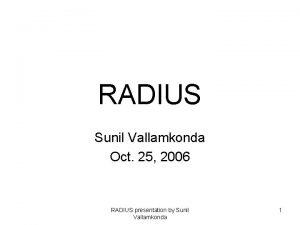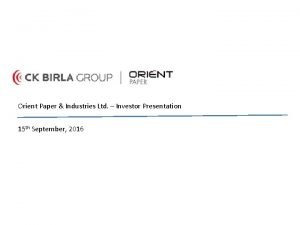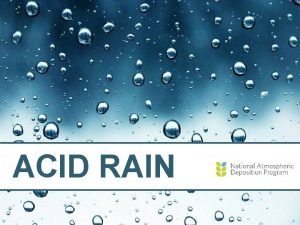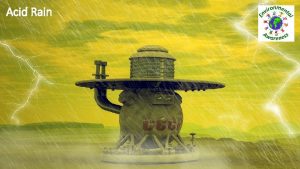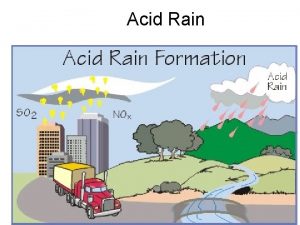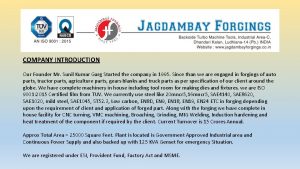RAIN INDUSTRIES Sunil Kumar Rain Industries PART I















- Slides: 15

RAIN INDUSTRIES - Sunil Kumar

Rain Industries PART - I

Disclaimer • This presentation is solely for discussion and knowledge sharing purpose • Examples shown are for understanding concepts and should not be considered as stock recommendations • Please do your own research and due diligence for any investment actions and/or consult an investment advisor for the same • Authors are not liable for any claims arising from use of the data provided neithere is any guarantee for accuracy of data • The views are our own and does not represent views of our employer in any manner



Green. Pet. Coke. . What is green about • Making of Petcoke • https: //www. youtube. com/watch? v=q. ZZig. Kd 43 NU • Pet coke is a byproduct of oil refining. The term “green” used in connection to pet coke refers to the raw, unprocessed pet coke which comes out of the Coker. It does not refer to environmental friendliness. • GPC has several different structural forms commonly referred to as needle coke(s<0. 6% and VM <5%), sponge coke(anode) S< 4%, V< 400 PPm, VM < 13%), and shot coke. Crude oil quality plays a major role in determining which of these is produced, although the Coker operation can also play a role. • GPC must be calcined or heat-treated at temperatures above 1200 C before it can be used to make anodes. It is necessary to drive out the VM during calcining so that the coke shrinks and densifies • Calciners always prefer GPC with a lower VM content because it results in a calcined product with lower porosity and higher bulk density. • Most of the world’s newly constructed refineries are configured to process heavy, sour crude oils that sell at a significant discount compared with light, sweet crudes. • Many existing refineries, particularly in the United States, have made capital investments to allow the processing of more heavy, sour crudes like those from Canada. These changes have directly impacted the quality and volume of GPC produced.

Types of Petcoke Petroleum coke Needle Made from either Fluid catalytic cracking (FCC)decant oil or coal tar pitch. Honeycomb Fuel Grade Coke Sponge Shot From Crude Refinery

Fuel Grade Pet Coke GPC(Fuel Grade Coke) High Sulphur Low Sulphur Anode Coke(Used to make CPC) Fuel for Power generation Desulfurization of petcoke A high sulfur content in pet coke reduces its market value and may prevent its use as fuel due to restrictions on sulfur oxides emissions for environmental reasons. Methods have thus been proposed to reduce or eliminate the sulfur content of petcoke. Most of them involve the desorption of the inorganic sulfur present in the pores or surface of the coke, and the partition and removal of the organic sulfur attached to the aromatic carbon skeleton.

CPC Every ton of aluminum , smelting process consumes 0. 4 tons of CPC Crude Oil GPC CPC • Byproduct • Calcination • Smelting Aluminum Every ton of aluminum consumes 0. 1 ton of CTP Every ton of aluminum consumes 0. 4 ton of CPC Each ton of metalarurgical coke gives 0. 04 ton of CTP Coal tar distillation yields approx 50% CTP, 40% aromatic oils and 10% napthalene oil. Therefore, production of primary aluminum is one of the most important determinants of demand for CTP/CPC


CPC Strategy

CTP Process Coal tar is a by-product generated through the processing of coal into coke for use in steel and iron manufacturing. Variety of intermediate chemical products derived from the coal tar distillation process, including the co-products of the distillation process. During the distillation process, heat and vacuum are utilized to separate coal tar into three primary components: carbon pitch , creosote oils and chemical oils.



Crude-Coal-Bauxite-Aluminium(relation)
 What is a bulk reducing industry
What is a bulk reducing industry Sunil vallamkonda
Sunil vallamkonda Sunil khatri tamu
Sunil khatri tamu Sunil batra nsdl
Sunil batra nsdl Supply chain management sunil chopra 6th edition ppt
Supply chain management sunil chopra 6th edition ppt Sunil thapar
Sunil thapar Sunil paudel
Sunil paudel Illusion of asymmetric insight
Illusion of asymmetric insight Sunil mukhi
Sunil mukhi Bmcc aatc
Bmcc aatc Stuart's medium
Stuart's medium Tactical sunil g
Tactical sunil g Dr l sunil chandran
Dr l sunil chandran Sunil dhola
Sunil dhola Dr l sunil chandran
Dr l sunil chandran Rain industries investor relations
Rain industries investor relations

